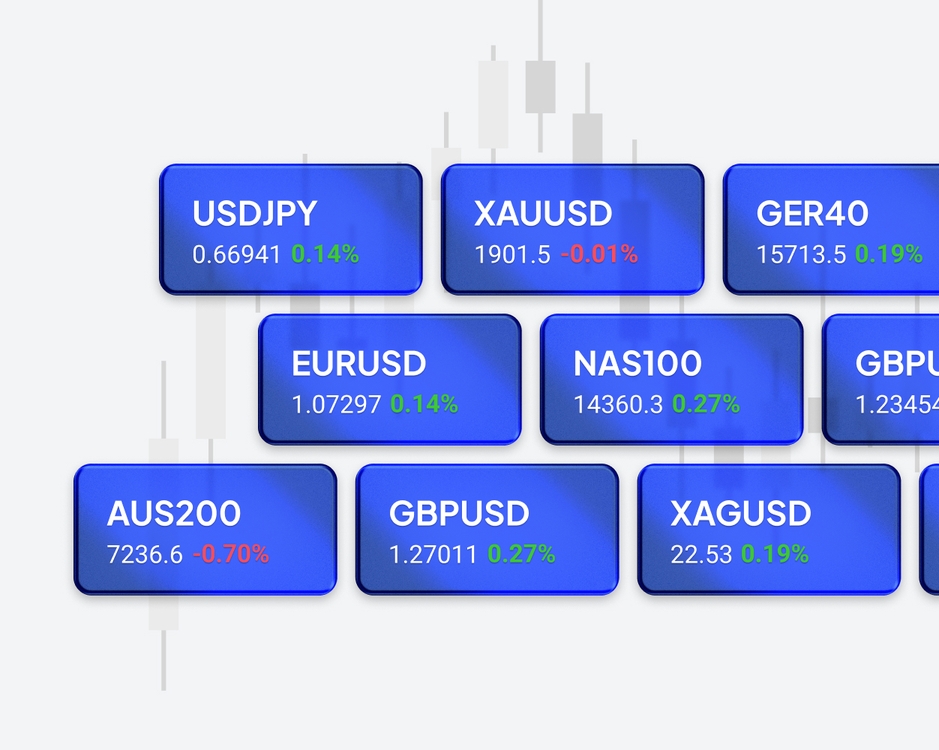KHÁM PHÁ CÁCH TỐT HƠN ĐỂ GIAO DỊCH
Truy cập vào thế giới CFD trên Forex, Tiền điện tử, Chỉ số, Hàng hóa và Cổ phiếu, đồng thời giao dịch trên thị trường toàn cầu theo cách của bạn với các nền tảng, công cụ giao dịch nhanh nhất và đáng tin cậy nhất thế giới, mức giá hấp dẫn và các tùy chọn thanh khoản sâu.
Pepperstone tự hào được bình chọn là Nhà môi giới TradingView của năm và Nhà môi giới MetaTrader 4 tốt nhất nhờ hỗ trợ khách hàng đẳng cấp thế giới của chúng tôi. Chúng tôi được quản lý tại 7 khu vực pháp lý trên toàn cầu và cung cấp các tùy chọn giao dịch trên 174 quốc gia. Pepperstone chỉ đơn giản là mang đến một cách giao dịch tốt hơn.
* Giải thưởng Nhà môi giới TradingView 2022 | Giải thưởng Good Money Guide 2023

TỰ DO GIAO DỊCH THEO CÁCH CỦA BẠN.
Mở khóa truy cập vào một loạt nền tảng giao dịch rộng lớn với Pepperstone.
TẠI SAO LÀ PEPPERSTONE?
Các công cụ bạn cần để đạt được tiềm năng giao dịch của mình
Giao dịch FX với mức chênh lệch 0,0 pip trên 14 cặp bằng tài khoản Razor của chúng tôi, với tính thanh khoản cao và không có báo giá lại.

Truy cập vào thế giới CFD trên Forex, Tiền điện tử, Chỉ số, Hàng hóa và Cổ phiếu, đồng thời giao dịch trên thị trường toàn cầu theo cách của bạn.

Tính thanh khoản của chúng tôi ở mức giá niêm yết là dẫn đầu ngành và được coi là một trong những mức tốt nhất trong kinh doanh.


Với tư cách là Khách hàng chuyên nghiệp, Bạn có quyền truy cập vào đòn bẩy cao hơn, các tính năng tài khoản độc quyền và đủ điều kiện tham gia chương trình Active Trader của chúng tôi.

Kiếm chiết khấu từ hoa hồng giao dịch và tiếp cận các lợi ích độc quyền dành cho Nhà giao dịch chuyên nghiệp có khối lượng lớn của chúng tôi. Tìm hiểu thêm

Các đối tác được tài trợ của chúng tôi


TIN TỨC & PHÂN TÍCH THỊ TRƯỜNG
Làm sắc nét lợi thế giao dịch của bạn
Phân tích thị trường giao dịch ngoại hối chuyên nghiệp, hiểu biết sâu sắc và đào tạo trong tầm tay bạn.

_(1).jpg)

NHẬN GIẢI THƯỞNG TỪ THE BEST
Trên toàn cầu, chúng tôi đã được trao giải bởi

Bạn đã sẵn sàng giao dịch?
Bắt đầu thật nhanh chóng và dễ dàng - chỉ cần nạp một khoản tiền nhỏ. Chỉ mất vài phút đăng ký với quy trình đăng ký đơn giản của chúng tôi.
*99.5% Tỷ lệ lấp đầy dựa trên tất cả dữ liệu giao dịch từ ngày 01/04/2024 đến ngày 30/06/2024
*Tất cả chênh lệch được tạo từ dữ liệu từ ngày 01/07/2024 đến ngày 31/07/2024
^ Các khoản phí và chi phí khác có thể được áp dụng.CFD là công cụ phức tạp và có nguy cơ mất tiền nhanh chóng do đòn bẩy. 87.2% tài khoản nhà đầu tư bán lẻ bị mất tiền khi giao dịch CFD với nhà cung cấp này. Bạn nên cân nhắc xem bạn có hiểu cách hoạt động của CFD hay không và liệu bạn có đủ khả năng chấp nhận rủi ro mất tiền cao hay không. Tham khảo RDN của chúng tôi và các văn bản pháp lý khác. Pepperstone Markets Limited, SCB số. SIA-F217.
**Những người đã có tài khoản Pepperstone
~Pepperstone có khách hàng tại hơn 160 quốc gia
giao dịch 24 giờ:
^Sau giờ làm việc bắt đầu từ 4:00 sáng theo giờ ET đến 9:30 sáng đối với phiên trước giờ thị trường và từ 4:00 chiều đến 8:00 tối theo giờ ET đối với phiên sau giờ thị trường. Thời gian qua đêm là từ 8 giờ tối đến 4 giờ sáng.
*Để biết thời gian chính xác, vui lòng tham khảo thông số kỹ thuật của công cụ trong thiết bị đầu cuối giao dịch. Giao dịch 24 giờ chỉ trên một số cổ phiếu chọn lọc của Hoa Kỳ.
~Tập đoàn Pepperstone bao gồm nhiều công ty với khách hàng đến từ hơn 160 quốc gia, tính đến 1-12-24





